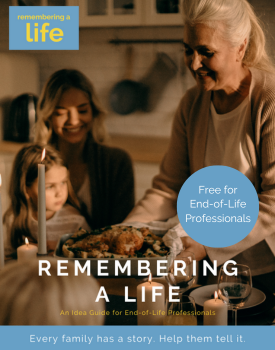How we remember a loved one is both a reflection and part of the grieving process.
At a funeral or life celebration, our spoken remembrances are often shaped by social etiquette which dictates that only funny or touching or positive memories be shared. For those closest to the deceased, these remembrances can sometimes feel at odds with recent memories of the suffering our loved one experienced at the end of life, a suffering we may have vicariously experienced with them.
As time moves on, we often come to understand that we do not move on from grief, but rather move forward with it. What this means is that our loss is always with us but in ever-changing shapes and forms due to the passage of time that takes us further and further away from the pain of immediate loss. At every juncture, this ever-changing landscape of our inner experience is also a reflection and part of the grieving process, a process that might require that we look at unresolved regrets and forgive whatever is in need of forgiveness, as well as embrace uncomfortable thoughts and feelings, in order to find acceptance and healing of our loss.
Remembering Charlotte
For three years, I worked in fund-raising for public television where I was fortunate enough to meet several women who became like big sisters to me. My friend Charlotte was one of those women. I sometimes think Charlotte and our mutual friends Kathy and Cathy purposefully took me under their collective wings as, perhaps, they thought I was in need of nurturing and mentoring. This is the only explanation I have ever been able to come up with regarding why three such inspirational women chose to befriend me.
Eighteen-years into our friendship Charlotte was diagnosed with brain cancer. What followed was two-years of watching Charlotte slowly, painfully, die.
For the first three months after her death, I could not seem to remember any of the happy times I had had with Charlotte. Instead, what seemed to be at the forefront of my Charlotte memory bank were those last painful years: driving Charlotte to and from the hospital for radiation treatments. Coaching Charlotte in stress management tools to help with anxiety related to her illness. Watching Charlotte lose her hair.
Another memory: having lunch with Charlotte and Kathy - which turned out to be the last time Charlotte had the ability to speak. I remember Charlotte and I were sitting in her home office, looking out the window together at the flowers she had planted in the front yard. I took Charlotte’s hand and said “what are you thinking about?” She responded, “Nothing. I’m just looking.” Those were the last words Charlotte ever said to me.
And then the day before she died, there was the distressing memory of visiting Charlotte and being aware that she was not being given enough pain and anxiety medication to foster departing earth with ease. I was with my friend Kathy; we decided to inform Charlotte’s sister of Charlotte’s suffering and Charlotte died peacefully the next day.
Relocating the Deceased
In grief support, ‘relocating the deceased’ is considered an important part of the grief-healing process.
Deciding where a loved one is for us now is one aspect of relocation; deciding for ourselves what kind of relationship we will have with our loved one going forth – how our relationship will continue – can be another. Periodically talking to our loved one, praying for them, remembering them through good works, and doing honoring activities (making your loved one’s favorite recipe etc.) are all examples of relocating the deceased.
As is remembering your loved one through spoken and written storytelling.
I began the process of relocating Charlotte in memory in order to come to terms with her death by writing about her in a grief journal. Over a period of several months I wrote about her several times a week, and in doing so the memories I wanted to carry forward began to break through, replacing the painful memories of Charlotte’s last months and years.
I was able to remember how Charlotte and Kathy and I would get together for martinis and three-hour dinners.
I was able to remember Charlotte’s gift for creating beautiful flower arrangements (she had once owned a floral shop) and how, when we went to flower shows, she knew the name of every flower (which I still find astonishing as I can never remember what flower is what).
I was able to remember that Charlotte was with me on the day my public speaking career began. I was invited to speak at a museum exhibit opening in Iowa where several of my art works were to be displayed. Charlotte and I, along with Kathy and Cathy, ‘road-tripped’ together from Milwaukee to Iowa, talking and laughing all the way. When I gave my talk, Charlotte hugged me close afterward and whispered in my ear, “Wow!” Then she pulled away and said, “Wow!” again and we both laughed.
And I was able to remember the last time Charlotte, Kathy and I and our husbands celebrated Charlotte’s birthday. We were all together at Kathy’s summer cottage. I had bought an 8” round, 8” high chocolate cake to mark the occasion. The very rich, very high calorie, very yummy cake was called ‘Chocolate Indulgence.’ Kathy told Charlotte to cut the cake; to everyone’s amazement, refined and classy Charlotte took the knife and uncharacteristically – quickly - definitely – and loudly – wacked the cake into six pieces. We all burst out laughing – and all tried to finish the gigantic pieces of cake Charlotte had cut for us.
These are the stories I think of now whenever I think of Charlotte. These are memories that emerged through story-writing and telling during the unfolding of my grief journey.
These memories house our continuing relationship.
These memories sustain me now whenever I think of Charlotte and what a gift it was to have had her in my life.


